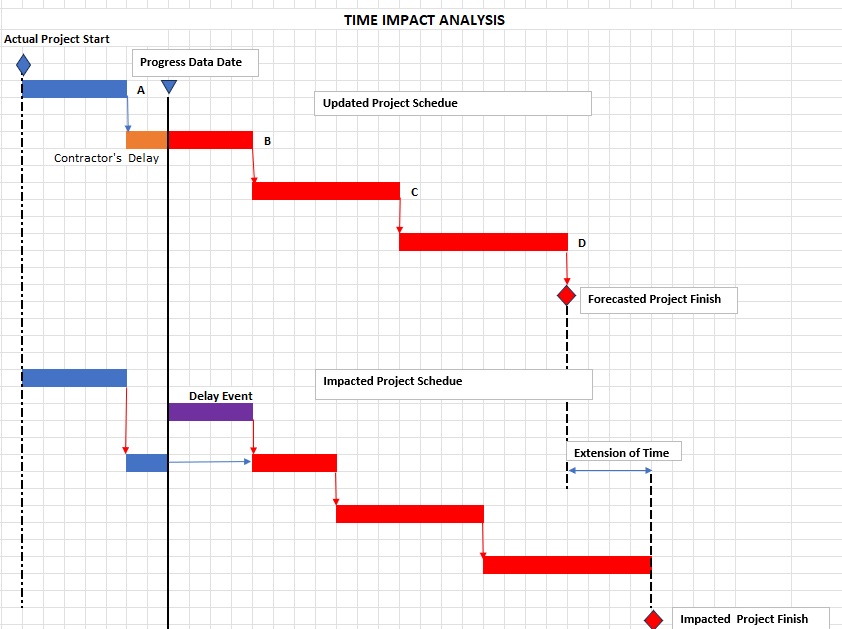Introduction
Time Impact Analysis is a popular delay analysis method to analyze the impact of delay events in a project schedule. The impact of a delay event is analyzed prospectively in this method. The baseline project schedule and the updated project schedule are required to perform a Time Impact Analysis. In this guide, we will discuss time impact analysis techniques that are used widely.
Baseline Project Schedule
The detailed project schedule for the complete scope of work in a project is developed in project management software tools such as Primavera P6, Microsoft Project, etc. as per the contract. Once the aforesaid detailed project schedule is agreed upon by all the stakeholders in the project, it is considered as baseline project schedule.
Updated Project Schedule
Updated Project Schedule prepared by updating the baseline schedule with the actual progress of works, with actual start, actual finish, and % of completion on a specific data date.
Time Impact Analysis Techniques
Time impact analysis shall be performed with the techniques as follows.
Creating Fragnets
- The fragnets are created for the sequence of events related to the delay event.
- The fragnets are to be as detailed as possible with the start date, and finish date of each event. The fragnets shall be created as realistically as possible.
Creating an Updated Project Schedule
- The updated project schedule shall be prepared based on actual dates and records.
- The updated project schedule is to be rescheduled with a new data date (progress cut-off date).
- The critical path and forecasted project finish date of the updated project schedule are observed and noted.
- The forecasted project finish date of the updated project schedule is observed. If there is a delay in the updated schedule with respect to the baseline schedule, it shall be recorded as the contractor’s delay. Creating an Impacted Schedule
Creating an Impacted Project Schedule
- A new WBS is to be added to the updated project schedule and the fragnet of delay event is to be inserted in the new WBS.
- The activities in the fragnets are to be linked with appropriate successor activities in the updated schedule.
- The impacted project schedule is rescheduled with above mentioned additional activities.
- The critical path and forecasted project schedule are observed and noted.
- The impacted longest path and completion date are compared against the recently progressed CPM Schedule. In situations where the delay activities impact the end milestones when compared to the updated schedule, the delay will be determined as shown in Figure 1 below.
- The amount of time extended for the project finish date in the impacted schedule with respect to the updated schedule is calculated in calendar days. This is the impact of the delay event, and the contractor is entitled to claim an extension of time for this duration.
- The Contractor may claim an extension of time for the extended duration in terms of calendar days as per the Contract.
Illustration of Time Impact Analysis
The TIA is shown in the following figure. The updated project schedule is delayed by the contractor’s delay. The forecasted project finish date of the updated project schedule is compared with the baseline schedule and recorded. In situations where the current completion date of the progressed schedule is late, the delay may be considered non-executable and the fault of the project contractor. The contractor is not entitled to a time extension.
Contact Leopard Project Control for your next Construction Scheduling project. We are your go-to company for construction project schedules.
The delay event is inserted in the updated schedule and linked to appropriate activities in the schedule. This is called an impacted schedule. It is observed that the project finish date of the impacted schedule is moved further due to the impact of the delay event. The extended period with respect to the updated schedule shall be the extension of time as depicted in figure 1 below.

Conclusion
The strengths of Time Impact Analysis are as follows.
- Time impact is relatively simple and easy to perform.
- The principles and techniques of Time Impact Analysis are easy to understand.
- This analysis is one of the fairest methods of analysis since it partially accounts for non-excusable delays (contractor’s delays).
The cons of Time Impact Analysis is as follows
- This delay impact is determined prospectively, which ignores the future rate of progress and the actual sequence of activities unless the forecast element of the critical path is checked against as-built records/latest updates.
For an effective time impact analysis, integrating CPM scheduling for construction can provide a clear and comprehensive view of project timelines. This technique helps ensure that you stay on track and within budget.





